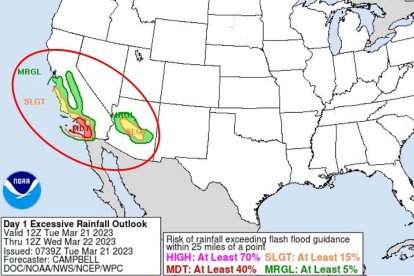California rains leave at least two dead and rainfall records set
Extreme winter weather and constant storms have left amounts of water unseen for 130 years (1893).

(Capture @NWSWPC / Twitter)
At least two people were killed in the latest storm recorded in California earlier this week. The atmospheric-river storm that hit the Golden State caused power outages to more than 135,000 homes and businesses during Wednesday morning.
Utility company Pacific Gas and Electric said the latest storm system "exceeded all expectations." Tuesday (March 21) broke five all-time records for one of the rainiest days in many years.
Downtown Los Angeles also broke its previous record of 130 years ago (set in 1893).
Statewide, more than 35 million people were under some type of weather alert, including a tornado warning in Ventura County.
Five people injured and more rain for the rest of the week
Five people were injured - four of them seriously - by falling trees during the storm, San Francisco Fire Department spokesman Johnathan Baxter said.
The National Weather Service forecasts rain, mountain snow and strong winds in parts of central and southern California to continue Wednesday and gradually abate on Thursday.
These areas could receive between 1 to 3 inches of rain and maximum wind gusts near 75 mph, according to National Weather Service expert Sarah Rogowski.
The NWS warned of "concerns for rapid runoff, flooding and landslides given the already wet and saturated ground conditions" for the remainder of the week. Up to 3 to 4 feet of snow could accumulate in the Sierra Nevada Mountains.
Atmospheric rivers in California
This winter season, the Golden State has suffered the consequences of the passage of at least 12 atmospheric rivers. These weather events have resulted in flooding, high winds, snow, damage to roads as well as public and private facilities in some communities, evacuation of people from their residences, and national and state weather emergency declarations.
Some scientists and meteorological experts have linked these weather phenomena to an increase in the amount of moisture in the atmosphere. That means that storms, like these atmospheric rivers, can bring more moisture inland, leading to increased rainfall rates and flash flooding.
Since the beginning of the winter season, it was estimated that cities such as Los Angeles received more than 24 inches of rain (twice the normal amount). San Francisco, Oakland, Sacramento, Sacramento, Stockton and Fresno increased their rainfall levels considered "normal" in this time period by more than 150%.
Extreme heavy rains have caused severe flooding in the communities. But they have also increased the water level in state reservoirs that have raised their reserves by more than 100 and 180 feet since December.
RECOMMENDATION





















